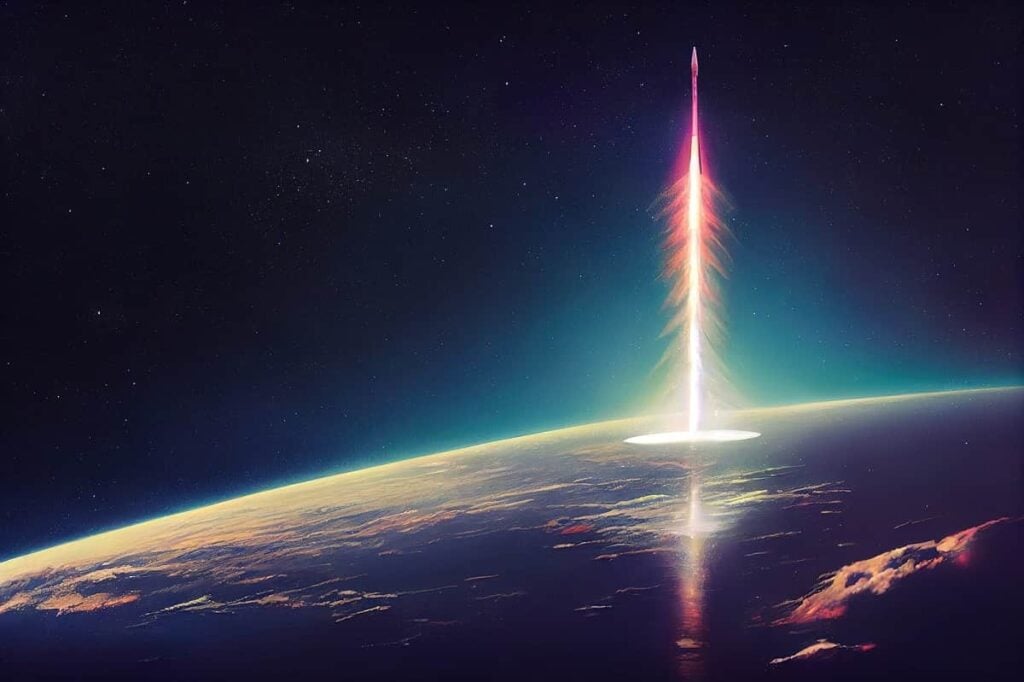Satellite Servicing Market Getting Ready to Launch
Table of contents

The Nanalyze Disruptive Tech Portfolio Report, available only to annual subscribers, is a constant work in progress. One of the toughest parts has been to find some decent space stocks to include because there are very few pure plays out there aside from satellite companies and the odd and highly speculative space tourism stock. Recently, we wrote about San Francisco-based Momentus, a company with a business model that could best be described as a taxi service for satellites to reach their final orbit. A pending merger with a special purpose acquisition company (SPAC) will give Momentus an estimated value of about $1.2 billion – despite only having about $90 million in contracts and having yet proven it can deliver the technology. We wouldn’t touch the stock with a ten-foot pole, but Momentus does alert us to a potentially lucrative market in the space industry – satellite servicing.
The Business Case for Satellite Servicing
The satellite industry currently represents nearly 75% of the $366 billion global space economy, according to Bryce Space and Technology. You’ll notice there’s a big chunk of the pie for satellite services like geospatial intelligence and internet:

That’s not what we’re talking about here. Satellite servicing refers to what companies like Momentus are proposing to do – provide a specific service such as refueling, in-orbit repair, assembly (including 3D printing), inspection, and relocation of satellites in the case of Momentus. For example, the value proposition from Momentus is that it can save customers as much as $35,000 per kilogram to transfer a satellite to its customized orbit after the initial trip into space. Whether that will ever fly – the whole operation relies on a specialized (and untested) water plasma propulsion system – is beside the point. (Anyone considering an investment in the stock would probably be more concerned with the past record of the company’s fearless leader.)
The real takeaway is that a whole new B2B market for satellite servicing is just now taking off. The reasons are pretty obvious, beginning with the fact that it costs hundreds of millions of dollars to build and launch sophisticated satellites. Sure, launch costs are dropping and smaller, cheaper satellites can now do the job of bus-sized satellites such as space radar. But there is still a great need for a space-based service and supply industry to extend the life of expensive space vehicles. The investment team at SpaceFund, which backs NewSpace startups and churns out industry reports, bullishly describes the emerging satellite-servicing market:
Tow trucks, gas stations, and robotic space mechanics will not only extend the life of space assets, they will also be the basis for an entirely new space economy built on the core frontier tenets of re-use, recycling, re-supply and repurposing. The full gamut of the in-space supply chain will develop in the coming 5 – 7 years, and is expected to be worth $10s of Billions by the end of the decade.
SpaceFund
While the hype around a trillion-dollar space industry has somewhat receded (maybe not at SpaceFund), there are many companies betting that they can (eventually) turn a profit in space by doing the blue-collar work.
Space Junk as a Service
There’s maybe no more blue-collar job than garbageman. And, as we all know by now, there’s plenty of space junk floating around Earth, especially the 3,000 already-dead satellites. In fact, the disposal of orbital debris will probably be among the biggest near-term commercial satellite servicing businesses.
One of the startups most likely to help clean up space is (not surprisingly) out of Japan. Founded in 2013, Astroscale has now raised $204.2 million in disclosed funding after a $51 million Series E in October during a year that was expected to kill off a few space startups. The company is tackling the problem on two fronts. It plans to launch a satellite to figure out the best way to capture some of the millions of bits of Death Star detritus strewn across our corner of the galaxy – what it calls active debris removal. Its satellite will observe and characterize a Japanese rocket body for eventual removal under an agreement with Japan’s national space agency.

The second pilot project by Astroscale is something that sounds like it would be offered by a funeral home. The End-of-Life Services by Astroscale demonstration (ELSA-d) satellite will test technologies for detecting and docking between two spacecraft, a larger servicer and a smaller client. The servicer is equipped with proximity rendezvous technologies and a magnetic docking mechanism, while the client has a ferromagnetic plate to make the secure connection. The ELSA-d is scheduled to launch out of Kazakhstan in March 2021 on a Soyuz rocket.

It also looks like Astroscale is expanding its satellite servicing repertoire with the June acquisition of a London outfit called Effective Space, which had raised $15 million to develop so-called hair life extension technologies for satellites. It’s not entirely clear what that will look like under Astroscale, but Effective Space had been working on some kind of drone that would perform on-orbit services like refueling.
Life Extension Services for Satellites
Astroscale claims “independent valuations” estimate that life extension and other on-orbit satellite services will generate more than $4 billion in revenues by 2028. While impossible to validate, we are encouraged to see that this market is being taken seriously by the likes of Northrop Grumman (NOC), a defense and aerospace giant with a $50 billion market cap. Most people probably think about the first part of the company’s business when you hear the name – things like stealth bombers and robotic military systems that will end all life as we know it.
But Northrop Grumman is a major player in space. It is the prime contractor on the James Webb Space Telescope, the successor to the Hubble Space Telescope. The company is also manufacturing the solid rocket boosters for the Space Launch System, one of two mega-rocket systems for NASA’s proposed deep-space missions. (Starship from SpaceX is the other one). And Northrop Grumman also happens to be one of the leaders in the nascent satellite servicing industry through its wholly owned subsidiary, SpaceLogistics.
SpaceLogistics is developing a range of satellite servicing technologies for space vehicles in orbit, beginning with what it calls a Mission Extension Vehicle (MEV). Each year, about 20 satellites simply run out of fuel, stranded in orbit. The MEV is designed to dock with geostationary satellites whose fuel is nearly depleted, using its own thrusters and fuel supply to extend the satellite’s lifespan by making the subtle corrections required to keep the vehicle on track. The MEV has a 15-year design life, meaning it can service multiple customers.

Speaking of customers: The first client to use the MEV is Intelsat (INTEQ), which operates one of the world’s largest satellite telecommunications systems. MEV-1 launched back in October 2019 before finally rendezvousing with an Intel satellite, IS-901, about 22,000 miles above Earth and racing at a speed of 7,000 miles per hour in February of this year. The technology is based on the same docking approach first used back in the 1960s: The MEV uses a patented mechanism to capture and dock with a satellite’s liquid apogee engine (LAE), a feature shared by about 80% of geostationary vehicles. Northrop Grumman and SpaceLogistics launched MEV-2 this past August, with plans to latch onto another Intelsat satellite in March 2021.

Other products in development for the company’s life extension line include Mission Extension Pods, smaller and less extensive propulsion systems for orbit control, and a Mission Robotics Vehicle, a more robust version of the MEV that will offer additional services. The SpaceLogistics mission got a big boost earlier this year when it was selected to replace Maxar Technologies (MAXR) as the commercial partner Robotic Servicing of Geosynchronous Satellites program under the shadowy government agency known as DARPA.
Staying Connected with a New Generation of Satellites
One of the key pieces of technology for satellite servicing is the interface like the one designed by SpaceLogistics. While most satellites sport LAEs, there are a few different designs out there. In addition, more and more satellites rely on only electric propulsion, which requires a different coupling interface. At some point, the industry will probably have to come together and decide on the equivalent of a USB for satellite servicing to ensure compatibility for docking between vehicles.
No doubt Colorado-based Altius Space Machines hopes it will play a role in that decision. Founded in 2011, the startup is developing a line of satellite interfaces, along with its own multi-purpose microsatellite servicing vehicle called Bulldog. We first profiled Altius in our 2019 article on space debris removal technologies alongside Astroscale. Shortly after, a new space startup, Voyager Space Holdings, acquired Altius as part of an ongoing spending spree to build a portfolio of space companies.

Altius is developing a suite of components (above) that can be added to a client satellite before launch to make it easier to grapple, refuel, and modularly repair or upgrade. The technology is focused on electropermanent magnets (EPMs) that require no moving parts and no power to maintain a powerful grip. The company says the tech has also applications right here on Earth, including industrial automation, fluid control, and autonomous systems. Meanwhile, the startup’s line of Bulldog microsatellite-scale servicing tugs will do everything from refueling to end-of-life disposal services, as well as active debris removal employing Altius’ robotic arms with sticky gecko-like grippers and electromagnetic booms for grasping objects tumbling out of control through space.
Gas Stations for Satellites
Last but not least is the company that first sent us down the wormhole of satellite servicing technologies. Founded in 2018, San Francisco-based Orbit Fab has raised $6.2 million for what it calls (and has trademarked) “gas stations in space,” including $2.6 million this year. The aforementioned SpaceFund is an investor, along with Munich Re (MUV2.MI), a global insurance company with a market cap of $34 billion. The company says it will launch its first fuel depot, Tanker 001 Tenzing, next year into a sun-synchronous orbit where it will be available to replenish fuel and sell overpriced energy drinks.

Orbit Fab has designed (and trademarked) specialized equipment for docking with its fuel depot. There’s the Self-Driving Satellite docking kit, known as SPARK, for guiding spacecraft without the need for complex robotic arms. It also has its own fluid transfer interface, trademarked under the name Satellite Gas Cap (and known by the acronym RAFTI). Orbit Fab says both technologies were developed in cooperation with about 50 companies and organizations, obviously competing in the same market as Altius for being the USB of satellite servicing. Interestingly, the startup lists Northrop Grumman as a partner on its website.
Update 09/07/2021: Orbit Fab has raised roughly $10 million in funding to further its goal to be the go-to source for orbital refueling. This brings the company’s total funding to $16.3 million to date.
Conclusion
SpaceFund lists about 35 companies within the satellite servicing sector, from more defense contractors/aerospace companies like Moog (MOG-A, MOG-B) and Airbus (AIR.PA) to small, low-profile (never heard of them) startups such as Modularity Space and Epic Aerospace. Not surprisingly, Northrop Grumman sits at the top of the heap, probably as much for its deep pockets as for its technology. Like so much in the commercialization of space, it will take years and millions of dollars for the satellite servicing market to mature. Everyone wants warp speed but we’re still working out the kinks for escaping Earth’s gravity.
Sign up to our newsletter to get more of our great research delivered straight to your inbox!
Nanalyze Weekly includes useful insights written by our team of underpaid MBAs, research on new disruptive technology stocks flying under the radar, and summaries of our recent research. Always 100% free.


















